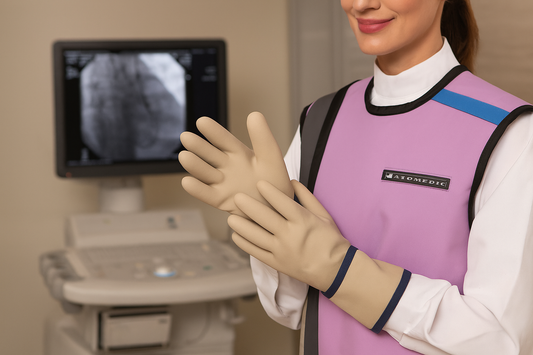In the field of radiology and interventional medicine, safety extends beyond aprons and vests. While chest, abdomen, and thyroid protection are widely recognised, the hands often face the greatest risk of exposure. For professionals working in interventional radiology, cardiac catheterisation, orthopaedic procedures, or dental imaging, the hands are frequently placed closest to the radiation source.
This makes X-ray protection gloves an essential part of personal protective equipment (PPE). Today’s advances in materials mean that lead-free gloves offer the same high level of protection with the added benefits of reduced weight, greater flexibility, and improved comfort.
Why Hand Protection Matters
Radiation exposure is cumulative. While a single procedure may not cause noticeable harm, repeated exposure across months or years adds up. The hands are particularly vulnerable, as they are often in the direct path of scatter radiation.
Unprotected hands can face risks such as:
-
Increased likelihood of radiation dermatitis
-
Higher risk of skin cancers with prolonged exposure
-
Joint and bone health concerns from cumulative exposure
-
Loss of dexterity from radiation damage
Proper hand protection ensures that professionals can continue working safely while minimising occupational hazards.
Key Considerations When Choosing Protection Gloves
Material Technology
Lead-free composites now match traditional lead protection, but without the environmental and weight drawbacks. These gloves are lighter, easier to wear for long procedures, and safer to dispose of when their life cycle ends.
Dexterity and Flexibility
For surgeons, radiologists, and dentists, hand precision is non-negotiable. The right gloves should provide protection without sacrificing tactile feedback. Modern designs balance shielding with thinness in the fingertips, allowing delicate manoeuvres.
Comfort and Fit
Protective gloves must be worn for extended periods. Poorly fitted gloves can cause fatigue or slip during procedures. Adjustable sizing and ergonomic designs prevent discomfort and ensure maximum protection.
Durability
Not all gloves are made equal. Some are designed for disposable use, while others are reusable and reinforced for long-term wear. For cost-effectiveness, durable lead-free gloves are preferred in high-exposure environments.
Practical Applications
Lead-free protection gloves are used in:
-
Interventional Radiology: to protect during fluoroscopy.
-
Orthopaedics: where hands are near imaging equipment.
-
Dental Practices: during frequent X-ray use.
-
Veterinary Medicine: where hands are often near the imaging area.
Frequently Asked Questions
Are lead-free gloves as effective as traditional lead gloves?
Yes. Modern composites provide equivalent shielding without the weight and environmental impact.
Do gloves reduce tactile sensitivity?
High-quality gloves are engineered to preserve dexterity, particularly in the fingertips.
Are they reusable?
Some models are reusable, with reinforced seams and durable outer layers. Always check manufacturer specifications.
Do all radiology staff need gloves?
Those whose hands are closest to the radiation source benefit most. They are especially critical for interventional specialists.
Helping Professionals Choose Wisely
Radiation protection gloves are not just accessories—they are essential safeguards for professionals who rely on their hands every day. By selecting lead-free options, healthcare providers benefit from lighter, safer, and environmentally responsible solutions.
For those ready to take the next step in protection, CavoMed’s X-Ray Lead-Free Protection Gloves provide unmatched comfort, shielding, and durability. Explore our collection and protect your hands without compromise.




